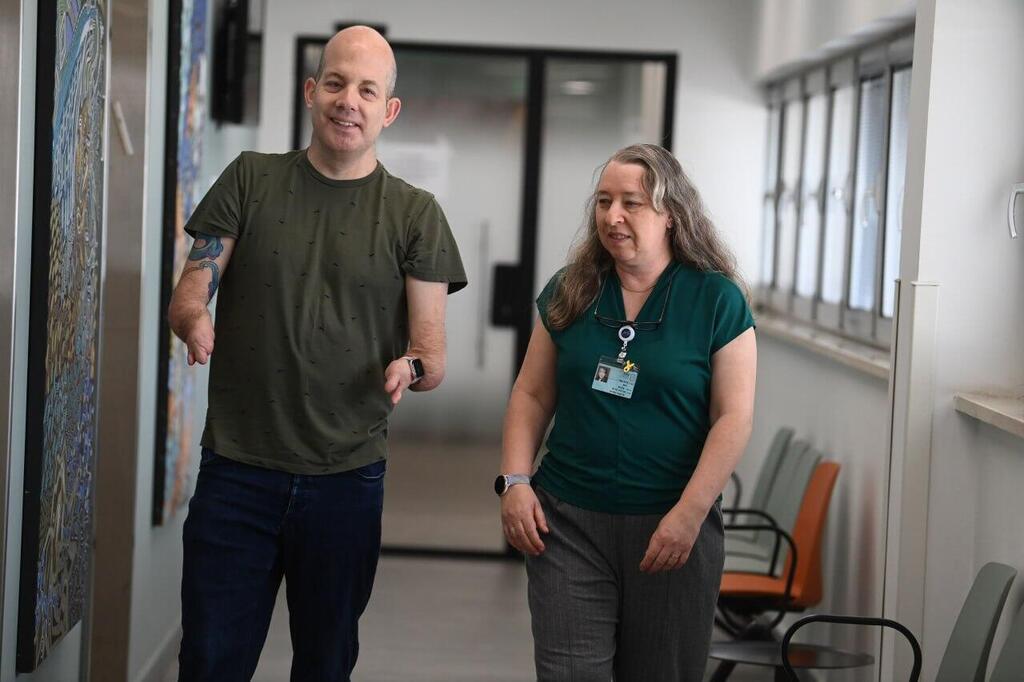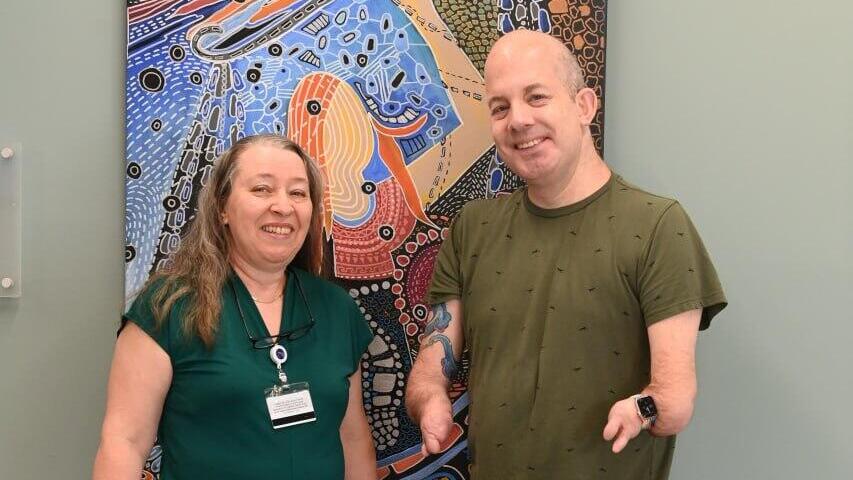Yoav Rokach Penn (47) was born without hands and with short arms as a result of a rare defect. After undergoing surgeries in childhood to build fingers using orthopedic means, designed to help him with daily functioning, he began suffering from severe neuropathic (nerve) pain in his hands, for which no solution was found.
After dozens of treatments he underwent in Canada, where he has lived with his family for over a decade, he found hope in Israel – in an innovative surgery recently performed at Sheba Medical Center in Tel Hashomer. “I feel excellent today, something I never believed I could say in the past,” he told ynet.
3 View gallery


Penn underwent a neural pacemaker implantation surgery performed by Dr. Ruth Gur at Sheba Medical Center
(Photo: Yair Sagi)
This is what the procedure he underwent looked like: Yoav says the pain began almost 20 years ago and has been getting worse since. “It’s paralyzing pain. A person isn’t supposed to feel all their organs, you don’t feel your nose or ear, and I was constantly feeling my hands, at an annoying and terrible level.”
Over the past decade, he was treated at a pain clinic in Canada with both medications and invasive measures such as steroid injections, nerve freezing, and radiofrequency treatment, which according to him only helped for a certain period. “In recent years I went through almost every possible type of treatment, conventional or unconventional, and received medications in insane doses – morphine in quantities of between 5 to 10 mg each time. It turns you into a zombie, and it’s terrible,” he adds.
Despite the disability he was born with, Yoav managed to maintain his independence throughout his life – “studies, degrees, great jobs, relocation, I did everything people dream about most,” he says, noting that despite the disability he got a driver’s license and was even the first disabled volunteer to go to officers’ training course. However, about two years ago, the pain became unbearable, and he was forced to leave his job and invest most of his efforts in finding a solution. “It’s a terrible feeling because it’s as if all the independence you had suddenly disappears.”
Implanting electrodes on nerves to control pain is a known procedure that has been performed for decades on patients suffering from severe chronic pain whom previous treatments failed to help. Dr. Ruth Gur explains that in these cases, spinal pacemakers are used that are implanted inside the body – and their electrodes reach the spinal cord to control the electrical signal in the cord and disperse the pain signals. “The electrodes essentially create an electrical field at certain frequencies that mimics nerve activity and ‘dresses’ the painful nerves, and we transmit through the electrodes something that masks the natural conduction of pain, meaning we block it,” she says.
3 View gallery


Dr. Adrian Greenfeld and Dr. Ruth Gur during a neural pacemaker implantation procedure for pain relief at Sheba Medical Center.
(Photo: Sheba Spokesperson)
According to her, in recent years, thanks to technological development, it’s possible to perform the implants also on peripheral nerves, meaning nerves outside the spinal column, such as in hands and legs. Dr. Gur explains that nerves usually have a long course, for example a leg nerve passes from the spinal cord to the tip of the foot. “Say someone was injured by shrapnel in the ankle, I can implant the pacemaker at knee or thigh level, far from that injury, and it will have an effect. But with Yoav, the anatomical damage and the surgeries he underwent over the years caused distortions along the entire nerve pathways. There’s no person like him in the world with such an anatomical structure, and therefore even though the technology exists, we had to reinvent the wheel with the surgery.” The one who operated with her is Dr. Adrian Greenfeld, a specialist in anesthesia and pain medicine.
“Surgery that hasn’t been done anywhere in the world”
Despite the complexity, Dr. Gur didn’t give up, and presented Yoav with the option of an exceptional surgery, with an approach to a central nerve junction that passes from the cervical spine near the collarbone area. During the surgery, the electrode is implanted on the nerve itself under live viewing of the electrode advancement by ultrasound according to a pattern designed based on an MRI performed in advance. Dr. Gur notes that the device is wireless, meaning the pacemaker is outside the body – and connected to it is an antenna that sits on the skin and transmits into a receiver located inside the electrode. From there the electrode transmits the electrical signals opposite to the electrical signals of the pain nerves – into the damaged nerve. “This specific surgery hasn’t been done anywhere in the world,” she says.
Dr. Gur explains that the main challenge in the surgery lies in its execution, in advance planning and in the sophistication required, as well as in the need for absolute precision in implanting the pacemaker on a specific nerve, given Yoav’s complex anatomical structure. According to her, there was much deliberation before the surgery. “There were too many question marks. And yet, we took a calculated risk because it’s definitely still within our capabilities,” she says.
Yoav says that the doctor who accompanied him in Canada did offer him a surgical option, but according to him what brought him to come specifically to Israel was the high level of medicine in the country, as well as the long waiting times in Canada, which can reach even three years. “The clinic didn’t even get around to making initial contact with me, and it was impossible to wait with this,” he said. Later it turned out that the surgery offered to him in Canada wasn’t at all suitable for his special anatomical case.
“It’s flattering that he came specifically to us,” Dr. Gur adds. “He was treated at a respectable pain clinic that didn’t even think to offer him this. This proves the excellence and professional level of our unit.”
Yoav recently underwent the surgery at Sheba, at this stage only in his right hand, and already now he testifies to significant relief in the pain. “Suddenly there’s light,” he says. “Since the surgery I haven’t taken any pain medication. If the pain was around 9 out of 10 before, today it’s 1. I didn’t believe it would work at this level, and certainly not so quickly, I was very skeptical. During the week or so that have passed since the surgery I kept convincing myself it wasn’t working, that it was just post-surgery euphoria. There’s also fear of disappointment after so many attempts, but after I was in a follow-up with Dr. Gur, she told me ‘it’s not placebo or euphoria, it’s an implant that’s working’.”
According to Dr. Gur, the success in Yoav’s surgery is an opening for patients who until now received a negative answer. “It gives us an understanding that we can use this technology also in exceptional things that aren’t by the book,” she says.
Pain of nerve origin can occur from a variety of causes – combat injury, car accidents, surgeries, and even nerve pain due to herniated disc or chronic inflammation. Dr. Gur explains that pain medicine, by any means, cannot cure the basic problem that caused the pain. “I can’t restore a hand that was amputated or reverse a condition after spinal surgery. The goal of pain medicine is to improve the patient’s quality of life as much as possible, but we can never predict with absolute certainty in advance if it will help, and if so, how much it will help. We define success as a reduction of 40%-50% of the pain.”Retry



